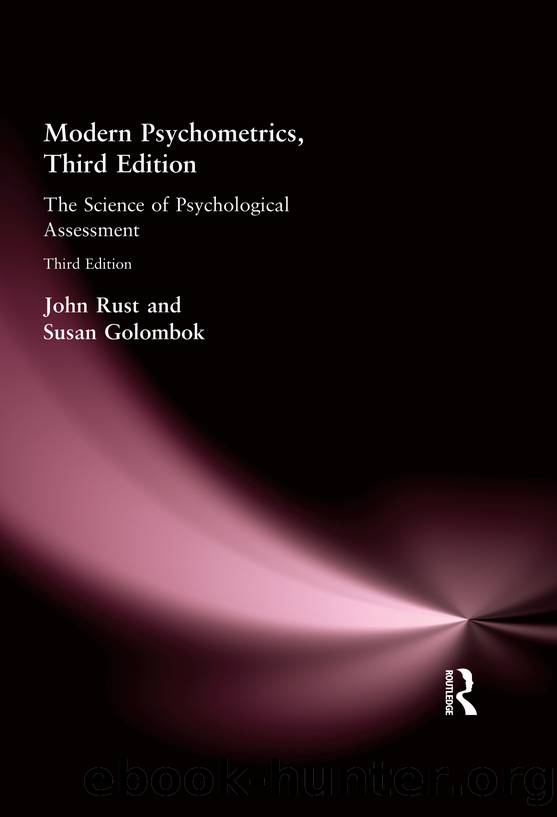Modern Psychometrics by Rust John Golombok Susan. & Susan Golombok

Author:Rust, John,Golombok, Susan. & Susan Golombok [John Rust]
Language: eng
Format: epub
ISBN: 9781317723769
Publisher: Taylor & Francis (CAM)
The reaction against exploratory factor analysis was carried to unreasonable extremes, which was unfortunate as it is a technique particularly suited to psychometrics. Much of the criticism has dealt with the inappropriateness of the factor analytic model within the hypothesis testing situation specified by the hypothetico-deductive model of science, where assumptions of normality and probability limit the interpretation of results. However, within item analysis, the constraints of the hypothetico-deductive model are not generally relevant unless hypotheses are actually being tested, and pragmatics often have a much larger say in whether items are selected. In the same way that item difficulties and item discriminations together with the test specification are used to make informed judgements, so various solutions using factor analysis can be informative about the number of subtests that are appropriate, the extent of guessing, the respondentâs selection of socially desirable items or the possibility of forms of cultural bias; and the use of factor analysis as a guide can be used to reduce any adverse effects. In real-life situations where tests are being used, it is better to be guided by a set of factor analytic solutions, even if only based on relatively small numbers of respondents, than not to be so guided. Factor analysis is now re-emerging as a pragmatic item analysis technique, and this has been helped in part by the development of log-linear models within factor analytic programs that are able to make adjustments for binary data.
The use of factor analysis for test construction is best seen in terms of validity. If we imagine the vector for the task and the vector for the test lying within the same factor space (as with the two vectors representing variables in Figure 7.2), then these will never in practice be perfectly identical. After all, validity is always a question of degree and thus we never expect perfect correlation between a test and its validation criterion. But the various different directions in which the test vector slants away from the task vector represent different possible forms of invalidity, and while the task vector itself will never appear within the factor analytic space, there will be vectors representing forms of contamination. Consider, for example, a factor analytic solution of the item correlation matrix for a personality test in which all positively scored items load on one factor and all negatively scored items on another (a not uncommon situation in practice). It is fairly evident if this happens that each of these factors has been contaminated by the acquiescence artefact. This occurs when some respondents have a tendency to agree with all the statements, whatever their content, whereas others tend to disagree with all the statements. To put the matter simply, some people tend to say yes to everything, while others tend to say no to everything, causing all the items to correlate positively with each other, regardless of content. If, however, we plot both of these factors on a piece of graph paper, we will almost certainly be able to
Download
This site does not store any files on its server. We only index and link to content provided by other sites. Please contact the content providers to delete copyright contents if any and email us, we'll remove relevant links or contents immediately.
Should I Stay or Should I Go? by Ramani Durvasula(7435)
Why We Sleep: Unlocking the Power of Sleep and Dreams by Matthew Walker(6366)
Fear by Osho(4497)
Flow by Mihaly Csikszentmihalyi(4493)
Rising Strong by Brene Brown(4195)
Why We Sleep by Matthew Walker(4193)
How to Change Your Mind by Michael Pollan(4115)
Too Much and Not the Mood by Durga Chew-Bose(4098)
The Hacking of the American Mind by Robert H. Lustig(4094)
Lost Connections by Johann Hari(3930)
He's Just Not That Into You by Greg Behrendt & Liz Tuccillo(3719)
Evolve Your Brain by Joe Dispenza(3507)
The Courage to Be Disliked by Ichiro Kishimi & Fumitake Koga(3264)
Crazy Is My Superpower by A.J. Mendez Brooks(3208)
What If This Were Enough? by Heather Havrilesky(3201)
Resisting Happiness by Matthew Kelly(3200)
Descartes' Error by Antonio Damasio(3168)
The Book of Human Emotions by Tiffany Watt Smith(3146)
In Cold Blood by Truman Capote(3141)
